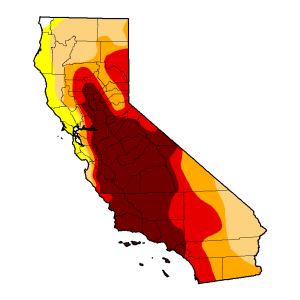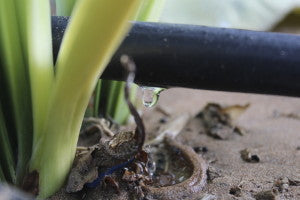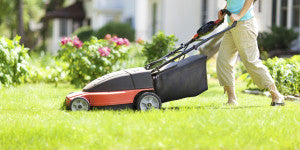Finally. After an unexpectedly warm, dry February, the Pineapple Express has dumped enough rain and snow on northern California to bring reservoirs there up to average levels – the first time they’ve been that high
since the drought began.
[caption id="attachment_20291" align="alignright" width="300"]

Drought Monitor - Released Thursday March 17, 2016[/caption]
This doesn’t mean the end of the state’s drought. The U.S. Drought Monitor’s latest report shows 55 percent of the state is still in extreme or exceptional drought. Groundwater is a major concern too. The state’s underground aquifers, which have been building their supply for hundreds or thousands of years, are being depleted far faster than they can be refurbished. Some of them have caved in and
will never recover.
The good news is the drought has been a wake-up call for the need to better manage water use.
Here’s how some people are trying to save water.
In California’s Central Valley, where a huge percentage of the food the U.S. eats is grown, declining aquifers have become a health hazard. Shallow municipal wells have gone dry as large agricultural companies draw down groundwater from deeper wells. This has left residents without water, or with polluted water.
One problem is, when a lot of rain falls, the area doesn’t have enough surface storage, like reservoirs, to keep it, according to a story in the
Christian Science Monitor. According to the story, George Goshgarian, an almond farmer in the San Joaquin Valley, is trying something new: flooding his almond orchards during the winter rainy season when his trees are dormant and don’t need the water.
The idea is, the water will soak into the ground and hopefully some will trickle into the aquifer below. If he’s careful, the flooding shouldn’t hurt the trees because they are dormant. Then, during the drier growing season, the ground will have more moisture. And the aquifer below will have a bit more water.
According to a study for the California Water Foundation that was cited in the story, groundwater in the southern San Joaquin is being depleted at a rate of 250,000 acre-feet per year on average. Using the rainy season’s runoff could reduce that amount between a third and a half, the study estimated.
Homeowners and municipalities are also trying to figure out how to use rainwater runoff. The Los Angeles Department of Water and Power last August presented a plan to capture more rainwater for the city.
According to Andy Lipkis, president of Tree People, which advocates for sustainable urban water use, an inch of rain falling on Los Angeles represents 7.6 billion gallons of water. Half that runs off into the ocean, he said in a story in the
Christian Science Monitor.
The utility’s master plan suggests projects to capture water that range in size from major basins to individuals’ yards.

The yard of Carrie Wassenaar of North Hollywood, Calif.,
is a case study in how water catching works. As described in the Christian Science Monitor, her yard has drought-tolerant plants watered by a drip-irrigation system that uses rainwater. A depression in the yard allows water to pool and seep down to the aquifer below. The water comes from an above-ground cistern that collects rainfall from her roof.
“You want to feel like you're at least trying to help with the solution instead of just contributing to the problem,”
she said in the story.
Ready.gov says the best way to prepare for a drought is to use less water beforehand. Here are some tips from ready.gov for saving water inside the home.
Replace washers in dripping faucets and repair pipe leaks.
“One drop per second wastes 2,700 gallons of water per year,” ready.gov said.
Insulate water pipes. This will reduce heat loss, which means it’ll take less time to heat water from the tap.
Install low-flow appliances, toilets, and shower heads. Some water districts will offer rebates to offset the cost.
Instead of rinsing dishes and using the disposal, scrape dishes into the trash or compost.

Outside, reduce the lawn and put in plants adapted to your climate.
According to a study, lawns cover an estimated 50,000 square miles of the country. That makes lawns the biggest crop in America. And you can’t even eat them.
Don’t water too much. Lawns only need about a
half inch of water per week and less in the autumn and winter. If water’s running down the gutter, you’re using too much.
Consider using
grey water for outdoor watering. For information about installing a rain catching system, check out the web site for the
American Rainwater Catchment Systems Association.
Be aware of regulations when considering water-saving tools. California offered homeowners tax-free rebates of up to $2,000 to help homeowners pay for water-efficient yards. As of February, the state had spent $22 million in rebates. Unfortunately, the
U.S. Internal Revenue Service is taxing those rebates as income.

 Drought Monitor - Released Thursday March 17, 2016[/caption]
This doesn’t mean the end of the state’s drought. The U.S. Drought Monitor’s latest report shows 55 percent of the state is still in extreme or exceptional drought. Groundwater is a major concern too. The state’s underground aquifers, which have been building their supply for hundreds or thousands of years, are being depleted far faster than they can be refurbished. Some of them have caved in and will never recover.
The good news is the drought has been a wake-up call for the need to better manage water use.
Here’s how some people are trying to save water.
In California’s Central Valley, where a huge percentage of the food the U.S. eats is grown, declining aquifers have become a health hazard. Shallow municipal wells have gone dry as large agricultural companies draw down groundwater from deeper wells. This has left residents without water, or with polluted water.
One problem is, when a lot of rain falls, the area doesn’t have enough surface storage, like reservoirs, to keep it, according to a story in the Christian Science Monitor. According to the story, George Goshgarian, an almond farmer in the San Joaquin Valley, is trying something new: flooding his almond orchards during the winter rainy season when his trees are dormant and don’t need the water.
The idea is, the water will soak into the ground and hopefully some will trickle into the aquifer below. If he’s careful, the flooding shouldn’t hurt the trees because they are dormant. Then, during the drier growing season, the ground will have more moisture. And the aquifer below will have a bit more water.
According to a study for the California Water Foundation that was cited in the story, groundwater in the southern San Joaquin is being depleted at a rate of 250,000 acre-feet per year on average. Using the rainy season’s runoff could reduce that amount between a third and a half, the study estimated.
Homeowners and municipalities are also trying to figure out how to use rainwater runoff. The Los Angeles Department of Water and Power last August presented a plan to capture more rainwater for the city.
According to Andy Lipkis, president of Tree People, which advocates for sustainable urban water use, an inch of rain falling on Los Angeles represents 7.6 billion gallons of water. Half that runs off into the ocean, he said in a story in the Christian Science Monitor.
The utility’s master plan suggests projects to capture water that range in size from major basins to individuals’ yards.
Drought Monitor - Released Thursday March 17, 2016[/caption]
This doesn’t mean the end of the state’s drought. The U.S. Drought Monitor’s latest report shows 55 percent of the state is still in extreme or exceptional drought. Groundwater is a major concern too. The state’s underground aquifers, which have been building their supply for hundreds or thousands of years, are being depleted far faster than they can be refurbished. Some of them have caved in and will never recover.
The good news is the drought has been a wake-up call for the need to better manage water use.
Here’s how some people are trying to save water.
In California’s Central Valley, where a huge percentage of the food the U.S. eats is grown, declining aquifers have become a health hazard. Shallow municipal wells have gone dry as large agricultural companies draw down groundwater from deeper wells. This has left residents without water, or with polluted water.
One problem is, when a lot of rain falls, the area doesn’t have enough surface storage, like reservoirs, to keep it, according to a story in the Christian Science Monitor. According to the story, George Goshgarian, an almond farmer in the San Joaquin Valley, is trying something new: flooding his almond orchards during the winter rainy season when his trees are dormant and don’t need the water.
The idea is, the water will soak into the ground and hopefully some will trickle into the aquifer below. If he’s careful, the flooding shouldn’t hurt the trees because they are dormant. Then, during the drier growing season, the ground will have more moisture. And the aquifer below will have a bit more water.
According to a study for the California Water Foundation that was cited in the story, groundwater in the southern San Joaquin is being depleted at a rate of 250,000 acre-feet per year on average. Using the rainy season’s runoff could reduce that amount between a third and a half, the study estimated.
Homeowners and municipalities are also trying to figure out how to use rainwater runoff. The Los Angeles Department of Water and Power last August presented a plan to capture more rainwater for the city.
According to Andy Lipkis, president of Tree People, which advocates for sustainable urban water use, an inch of rain falling on Los Angeles represents 7.6 billion gallons of water. Half that runs off into the ocean, he said in a story in the Christian Science Monitor.
The utility’s master plan suggests projects to capture water that range in size from major basins to individuals’ yards.
 The yard of Carrie Wassenaar of North Hollywood, Calif., is a case study in how water catching works. As described in the Christian Science Monitor, her yard has drought-tolerant plants watered by a drip-irrigation system that uses rainwater. A depression in the yard allows water to pool and seep down to the aquifer below. The water comes from an above-ground cistern that collects rainfall from her roof.
“You want to feel like you're at least trying to help with the solution instead of just contributing to the problem,” she said in the story.
Ready.gov says the best way to prepare for a drought is to use less water beforehand. Here are some tips from ready.gov for saving water inside the home.
Replace washers in dripping faucets and repair pipe leaks.
“One drop per second wastes 2,700 gallons of water per year,” ready.gov said.
Insulate water pipes. This will reduce heat loss, which means it’ll take less time to heat water from the tap.
Install low-flow appliances, toilets, and shower heads. Some water districts will offer rebates to offset the cost.
Instead of rinsing dishes and using the disposal, scrape dishes into the trash or compost.
The yard of Carrie Wassenaar of North Hollywood, Calif., is a case study in how water catching works. As described in the Christian Science Monitor, her yard has drought-tolerant plants watered by a drip-irrigation system that uses rainwater. A depression in the yard allows water to pool and seep down to the aquifer below. The water comes from an above-ground cistern that collects rainfall from her roof.
“You want to feel like you're at least trying to help with the solution instead of just contributing to the problem,” she said in the story.
Ready.gov says the best way to prepare for a drought is to use less water beforehand. Here are some tips from ready.gov for saving water inside the home.
Replace washers in dripping faucets and repair pipe leaks.
“One drop per second wastes 2,700 gallons of water per year,” ready.gov said.
Insulate water pipes. This will reduce heat loss, which means it’ll take less time to heat water from the tap.
Install low-flow appliances, toilets, and shower heads. Some water districts will offer rebates to offset the cost.
Instead of rinsing dishes and using the disposal, scrape dishes into the trash or compost.
 Outside, reduce the lawn and put in plants adapted to your climate. According to a study, lawns cover an estimated 50,000 square miles of the country. That makes lawns the biggest crop in America. And you can’t even eat them.
Don’t water too much. Lawns only need about a half inch of water per week and less in the autumn and winter. If water’s running down the gutter, you’re using too much.
Consider using grey water for outdoor watering. For information about installing a rain catching system, check out the web site for the American Rainwater Catchment Systems Association.
Be aware of regulations when considering water-saving tools. California offered homeowners tax-free rebates of up to $2,000 to help homeowners pay for water-efficient yards. As of February, the state had spent $22 million in rebates. Unfortunately, the U.S. Internal Revenue Service is taxing those rebates as income.
Outside, reduce the lawn and put in plants adapted to your climate. According to a study, lawns cover an estimated 50,000 square miles of the country. That makes lawns the biggest crop in America. And you can’t even eat them.
Don’t water too much. Lawns only need about a half inch of water per week and less in the autumn and winter. If water’s running down the gutter, you’re using too much.
Consider using grey water for outdoor watering. For information about installing a rain catching system, check out the web site for the American Rainwater Catchment Systems Association.
Be aware of regulations when considering water-saving tools. California offered homeowners tax-free rebates of up to $2,000 to help homeowners pay for water-efficient yards. As of February, the state had spent $22 million in rebates. Unfortunately, the U.S. Internal Revenue Service is taxing those rebates as income.


